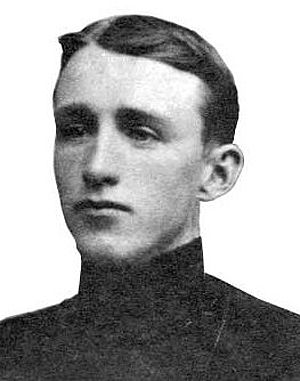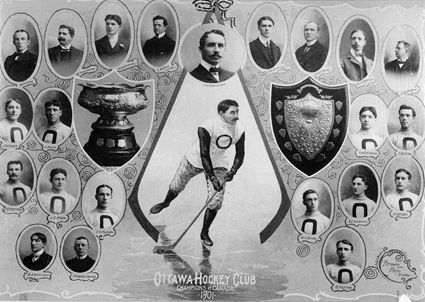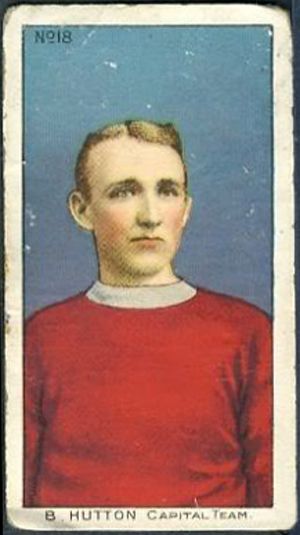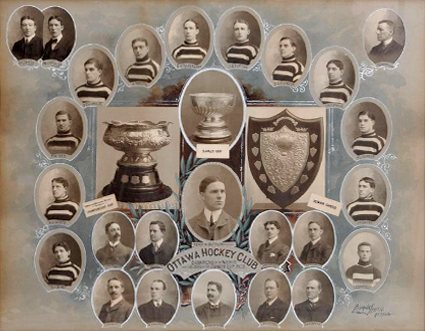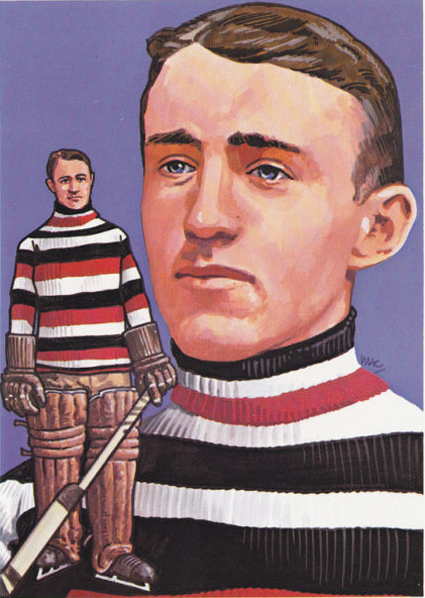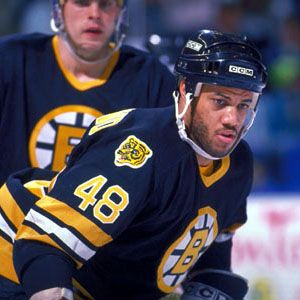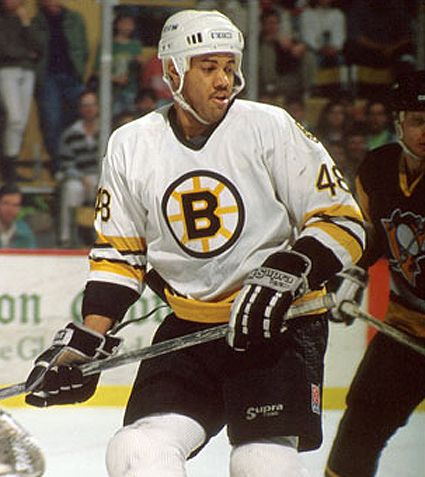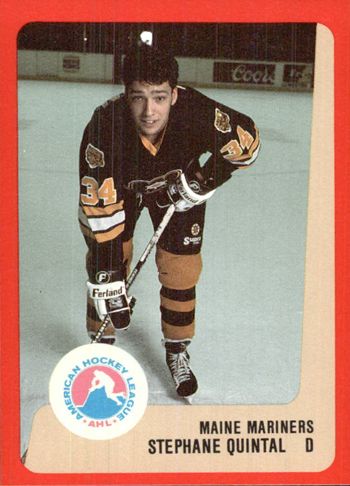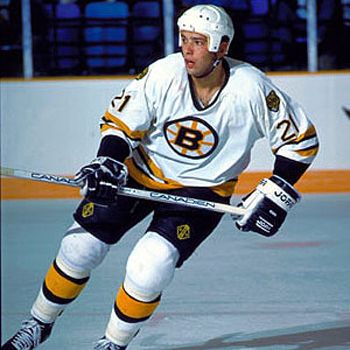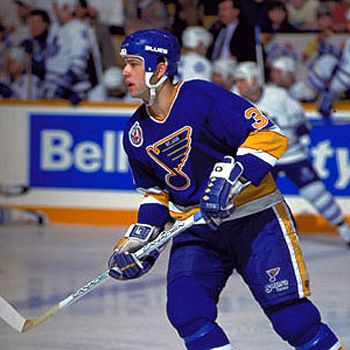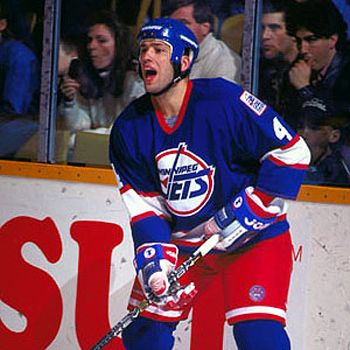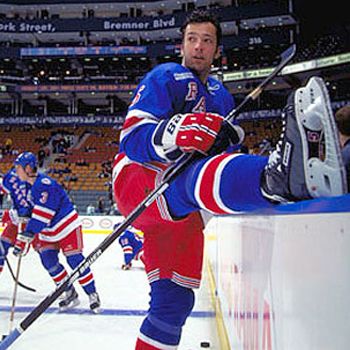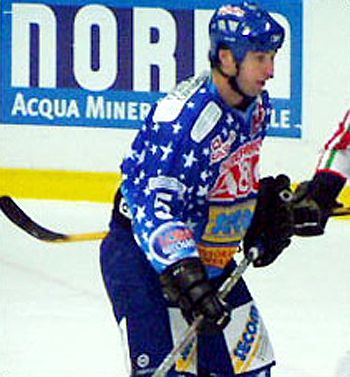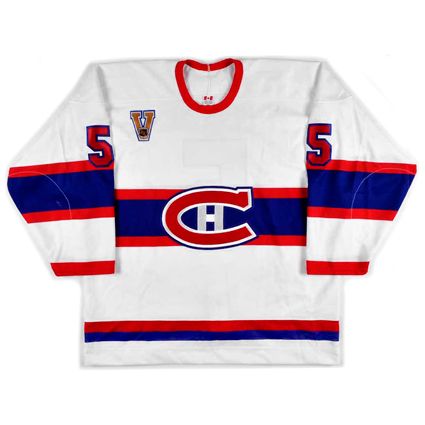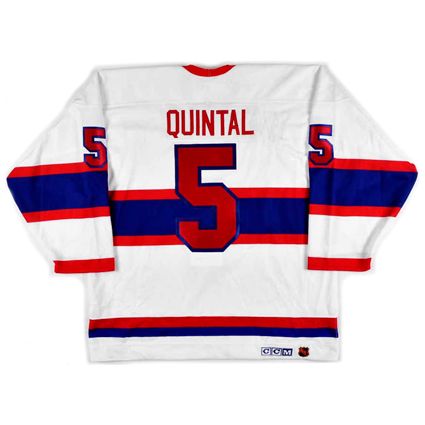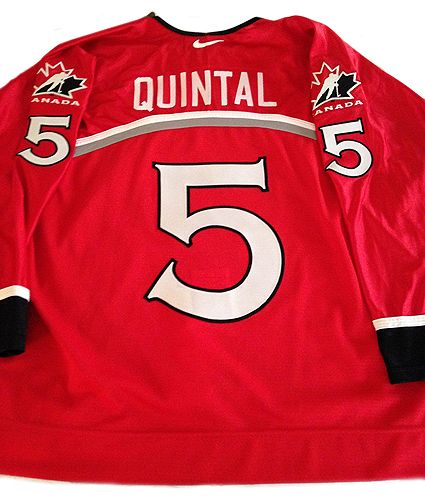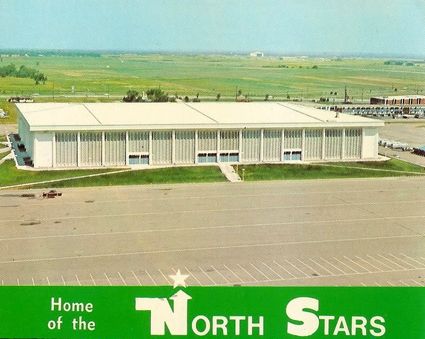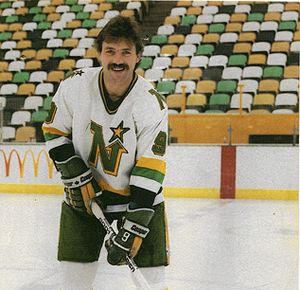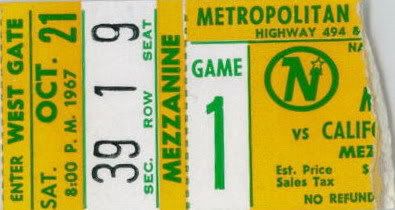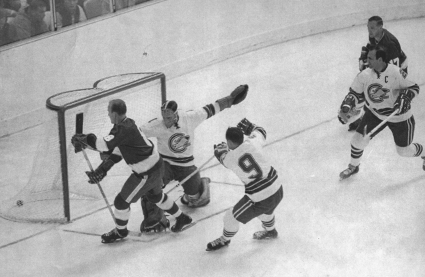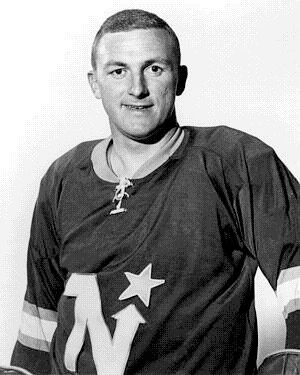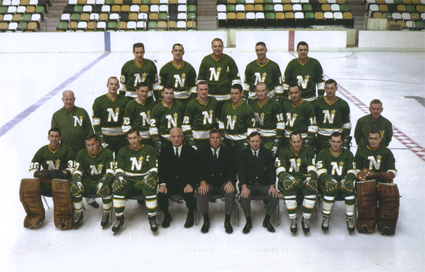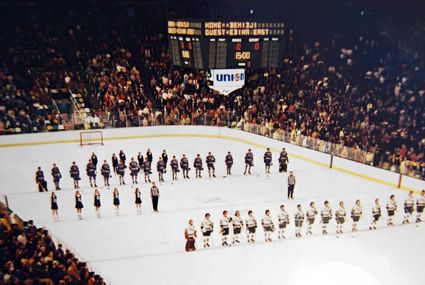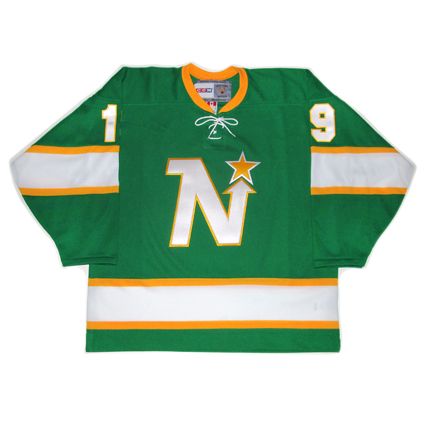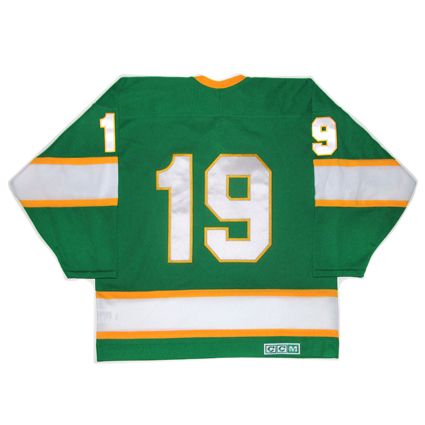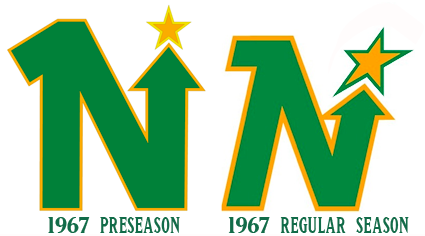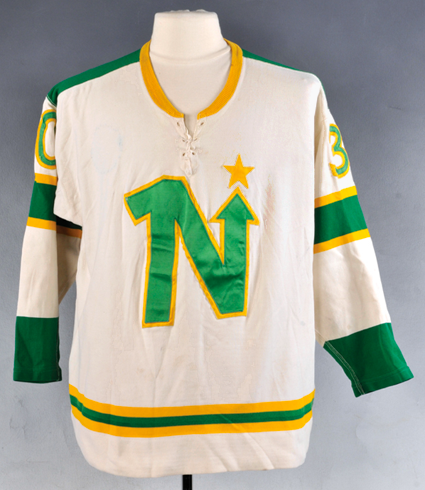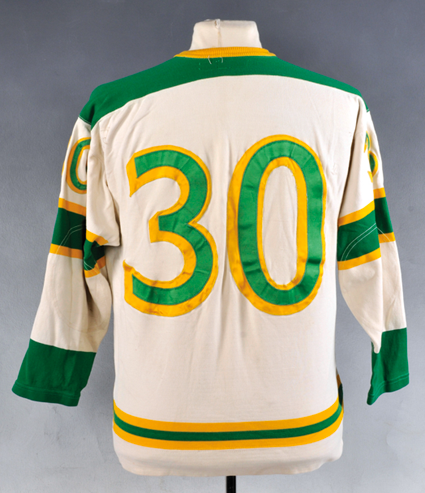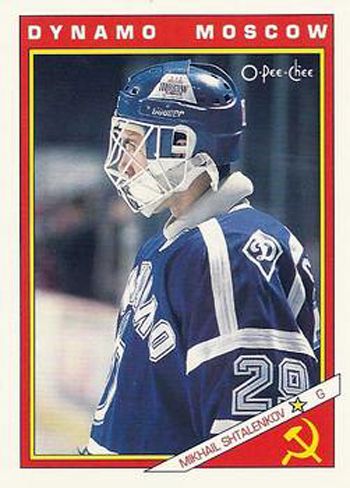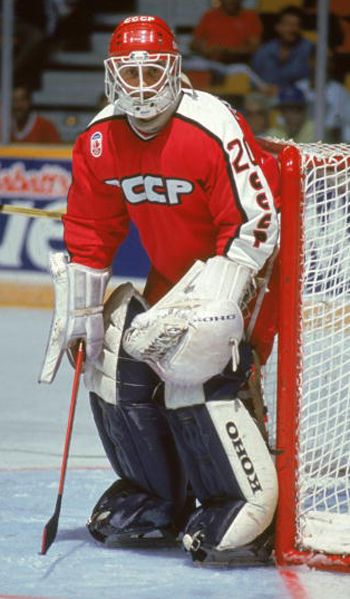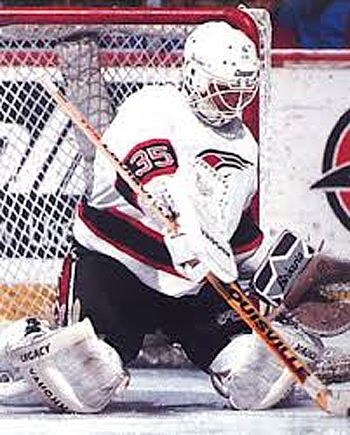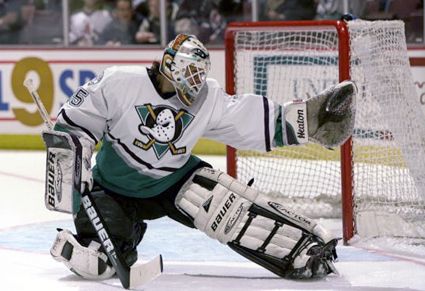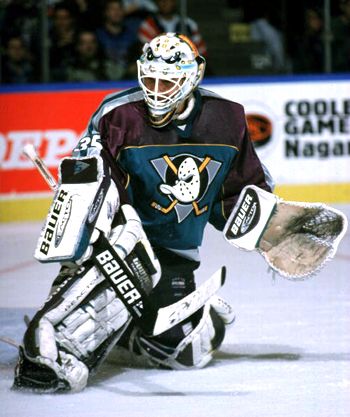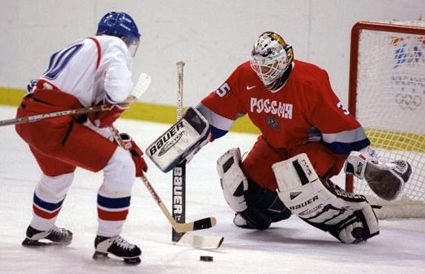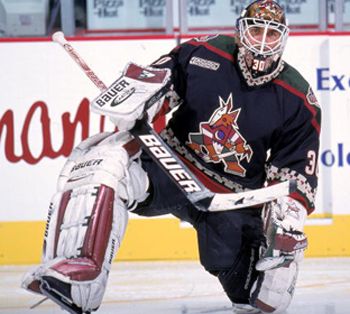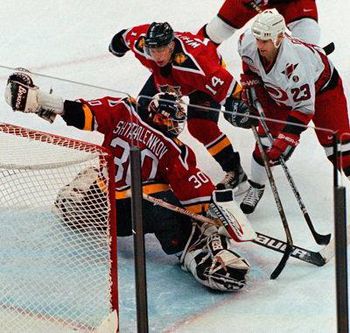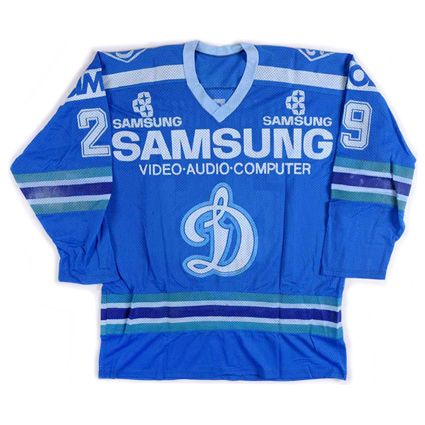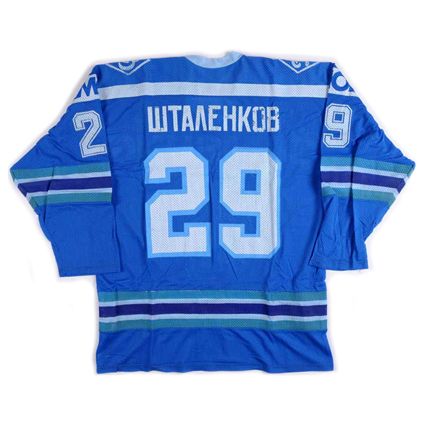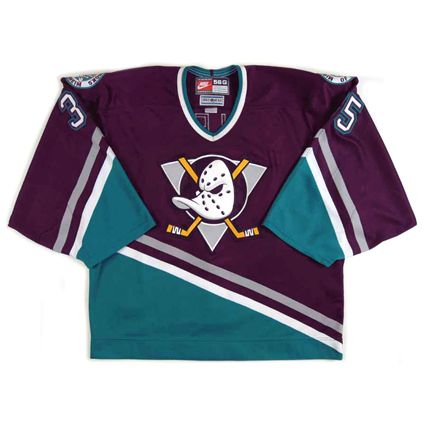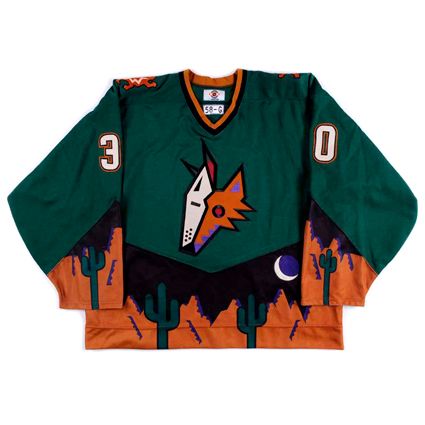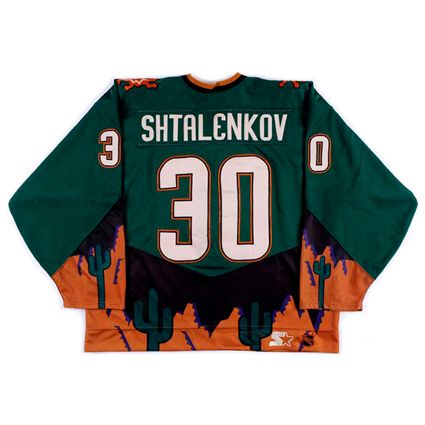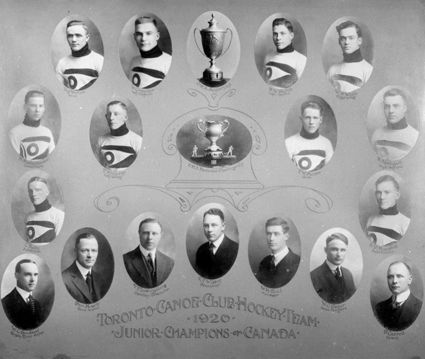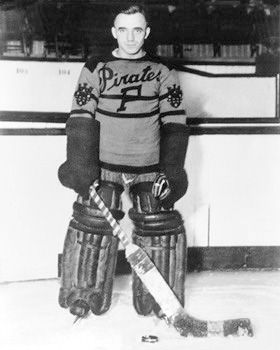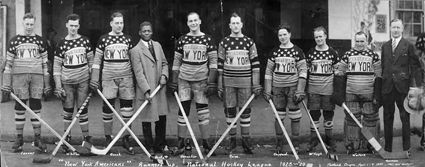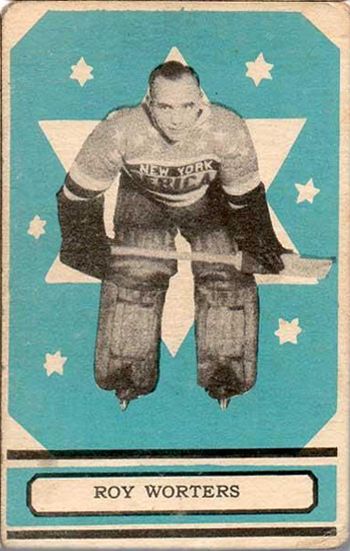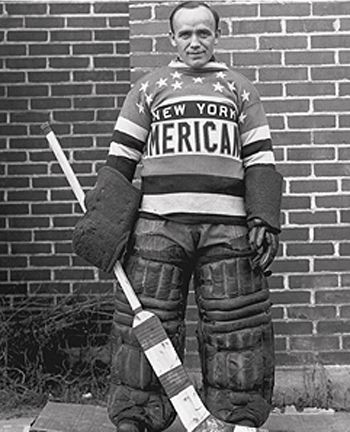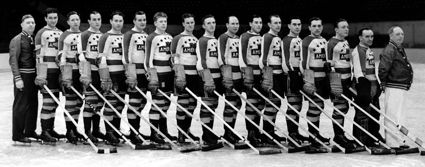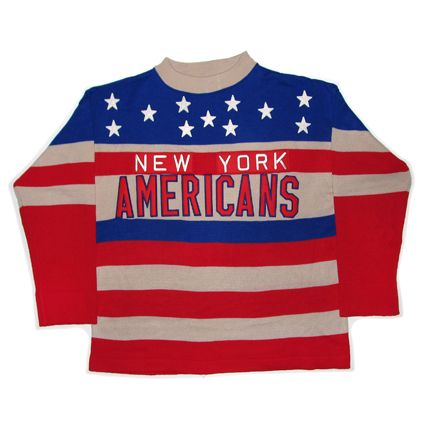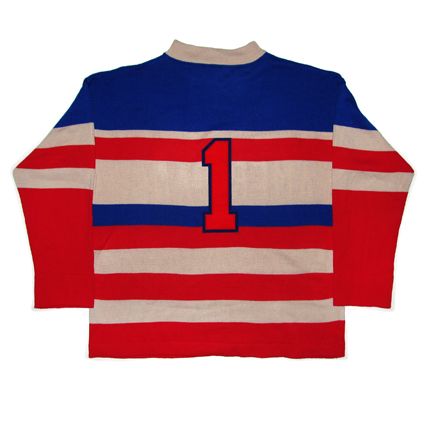Saturday, October 24, 2015
1903 Ottawa Senators Bouse Hutton Jersey
One of history's most accomplished multi-sport talents, John "Bouse" Hutton, was born on this date in 1877. His hockey career began in 1899 with two appearances for the Ottawa Hockey Club, then members of the Canadian Amateur Hockey League.
John "Bouse" Hutton
Hutton, a goaltender, then took the reigns by playing in 7 of the team's 8 games in 1900, completing the season with a 2.71 goals against average which was second best in the CAHL. He would go undefeated in 1901 with a 7-0-1 record to carry Ottawa to the league championship while lowering his goals against average to 2.50 to lead the league.
The 1901 Ottawa Hockey Club
After the conclusion of the hockey season, Hutton also played in goal for the Ottawa Capitals for the summer lacrosse season and won the inaugural Minto Cup as the top senior team in Canada.
A Bouse Hutton lacrosse card
He would again tie for the best goals against average in 1902 at 1.70, which included a pair of shutouts while once again playing in all 8 games. Prior to the start of the winter hockey season, Hutton would win another championship, only this one as a fullback for the Ottawa Rough Riders of Canadian football.
Ottawa would return to the top spot in the standings in 1903 as Hutton again contributed a pair of shutouts.
At the conclusion of the regular season, Ottawa defeated the Montreal Victorias in a two-game total goals series. After a 1-1 tie in the opening game, Ottawa cruised to the title with a 8-0 romp in game two to be awarded the Stanley Cup as league champions. Four days later they defended the cup by defeating the Rat Portage Thistles 6-2 and 4-2 in a best-of-three.
The 1903 holders of the Stanley Cup - The Ottawa Silver Seven
Prior to the start of the 1904 season, Ottawa, now known as "The Silver Seven" after the players were each awarded a silver nugget for winning the Stanley Cup, defended their trophy against a challenge from the Winnipeg Rowing Club. They successfully turned back the visitors in their best-0f-three series by winning the first game 9-1 and, after dropping the second 6-2, retained the cup following their 2-0 win as Hutton added another shutout to his record.
As the landscape of the hockey world was an unsettled one during it's formative years, Hutton won all four of Ottawa's games in the CAHL before the team withdrew from the league at mid-season.
Having retained possession of the cup despite leaving the CAHL, Ottawa would easily turn back the challenge of the Toronto Marlboros 6-3 and 11-2 in their best-of-three series in late February. A week later a two-game total goal series was arranged against the Montreal Wanderers. Regulation time of the first game ended 5-5, Montreal refused to play an overtime, demanding the game be considered a no-contest and requested the series start over as a best-of-three. When that proposal was turned down, Montreal abandoned their challenge and Ottawa not only retained the cup, but were also named champions of the Federal Amateur Hockey League (the league the Wanderers were members of and Ottawa was scheduled to join the following season after leaving the CAHL) despite never having played a game in the league at the time!
The Silver Seven had one more challenge to face that season, this from the Brandon Wheat Cities club, whom Ottawa would easily handle 6-3 and 9-3. Hutton's record in Ottawa's cup challenge games was 6-1-1 with a 2.90 goals against.
Following the 1904 hockey season Hutton retired from hockey to focus on lacrosse where he won a second Minto Cup with the Capitals. Following their championship, the Capitals toured England and won 23 out of 24 games.
Having been retired from hockey for five years, Huton returned to the ice in 1909 with a new club named the Ottawa Senators in the same FAHL as his original team, the Ottawa Silver Seven, who had by then moved onto yet another league. In five games, Hutton finished with a record of 3-2 with one shutout to end his career for good.
Hutton was elected to the Hockey Hall of Fame in 1962.
Today's featured jersey is a 1903 Ottawa Silver Seven Bouse Hutton jersey with the Senators trademark black, red and white horizontal "barberpole" stripes. This style of jersey was first adopted in 1903, and except for one season with vertical stripes in 1910-11, remained in use through the original Senators final season in Ottawa of 1933-34, with the addition of the letter "O" crest from 1929-30 on.
Labels:
Hutton Bouse,
Ottawa Senators,
Ottawa Silver Seven
Friday, October 23, 2015
1990-91 Boston Bruins Graeme Townshend Jersey
The only player in NHL ever born in Jamaica, Graeme Townshend was born on this date in 1965. He moved to Canada in 1969 and eventually played college hockey in the United States at Rensselaer Polytechnic Institute in the ECAC for four years with a high of 22 points in 31 games as a senior.
At the conclusion of his college career, he was signed by the Boston Bruins organization who assigned him to their farm team, the Maine Mariners of the AHL. He spent the majority of the 1989-90 season, but made his NHL debut with four games in Boston, becoming the first Jamaican born player ever in the NHL.
He was back in Maine for more seasoning in 1990-91, but did manage 18 games with the Bruins, which included the first two goals of his career.
For the next two seasons he became a member of the New York Islanders organization after signing a free agent deal. Again, Townshend spend the majority of his time in the AHL, now with the Capital District Islanders, including an AHL high of 29 goals and 50 points in 1992-93. In two years he did skate in 9 games with the parent club where the right wing added another goal to his stats.
On the move again, Townshend signed with the Ottawa Senators for 1993-94, playing in a career best 14 NHL games that season. In his 56 games with the AHL's Prince Edward Island Senators, he scored 16 goals and 29 points.
Beginning in 1994-95, Townshend began a tour of duty in the IHL. He played three games with the Minnesota Moose and found some stability with the Houston Aeros, where the rugged grinder played 71 games, scoring 19 goals an registering a career high 204 penalty minutes.
Houston was good for his career and it showed with back to back 21 goal seasons in 1995-96 and 1996-97. He was also named the IHL's Man of the Year in 1996.
He played single games for the Aeros and Utah Grizzlies at the start of 1997-98 before joining the Lake Charles Ice Pirates of the short-lived Western Professional Hockey League. He led the club in scoring with 43 goals and 44 assists for 87 points. After one more season with Lake Charles he retired as a player and has stayed active in hockey, including coaching, and is now running Townshend Hockey Skating Systems as well as being the skating and skills coach for the Toronto Maple Leafs.
Today's featured jersey is a 1989-90 Boston Bruins Graeme Townshend jersey. This classic Bruins jersey was adopted in 1974 and underwent minor changes, such as the addition of a secondary logo and names on the back, but remain essentially the same through 1995.
Here are the two goals Townshend scored while a member of the Boston Bruins.
Here is Townshend teaching at his hockey school, which focuses on skating to take advantage of the new rules in hockey.
Labels:
Boston Bruins,
Townshend Graeme
Thursday, October 22, 2015
2003-04 Montreal Canadiens Stephane Quintal Jersey
French-Canadian defenseman Stephane Quintal, born on this date in 1968, first played junior hockey for the Granby Bisons of the Quebec Major Junior Hockey League. He immediately became a solid contributor, playing in 67 games as a rookie. So impressive was his debut season that Quintal was named team captain for the 1986-87 season at just 17 years old.
He impressed with his growth on the ice that season, as he raised his point total from 19 during his rookie year to 54 from 13 goals and 41 assists. This performance did not go unnoticed, as Quintal was chosen #14 overall in the first round of the 1987 NHL Entry Draft by the Boston Bruins.
He returned to Granby for the following season and was again the team captain, but after 23 games he was traded to the Hull Olympiques. He would only play 15 regular season games for Hull, but would see action in 19 playoff games as Hull would make it all the way to the semifinals of the 1988 Memorial Cup where he contributed an average of a point per game.
For the next three seasons Quintal would divide his time between the Bruins of the NHL and the Maine Mariners of the AHL, playing an increasing role with the Bruins with 26 games in 1988-89, to 38 to 45 in 1990-91.
He finally cracked the Bruins lineup full time in 1991-92, but after 49 games he and Craig Janney were dealt to the St. Louis Blues for Adam Oates.
His time in St. Louis was somewhat brief though, as he would finish that season with 26 games and play the full 1992-93 season with the Blues before being dealt to the Winnipeg Jets with Nelson Emerson for Phil Housely.
Quintal immediately set a new personal best in points with 26 his first season with Winnipeg, as well as accumulating a career high in penalty minutes with 119 in 1993-94. Despite not racking up huge penalty minute numbers, when the situation called for it, Quintal was not afraid to battle with some of the most feared fighters in the NHL at a time when some of the game's all-time toughest were ready to drop the gloves.
The following season of 1994-95 Quintal him nearly match his point production with 23 as well as improving his +/- by a full 25 points.
Quintal was once again on the move, as he was acquired by the Montreal Canadiens prior to the 1995-96 season. For the 1996-97 season Quintal would be named one of the team's assistant captains and in 1998-99 he would set a career high with 27 points. Following the conclusion of the NHL season, Quintal would make the only international appearance of his career when he was part of the Canadian roster at the 1999 World Championships in Norway. He acquitted himself well, scoring 3 goals and 5 points in 10 games and served as one of the team's assistant captains.
For the 1999-00 season, Quintal signed as a free agent with the New York Rangers, where he played 75 games.
Just prior to the 2000-01 season, he was claimed off waivers by the Chicago Blackhawks, the fourth Original Six club of his career. With Chicago, he put up his usual numbers, playing in 75 games and scoring 18 points, just as he had done for the previous six seasons with little variance.
During the summer, the Blackhawks dealt Quintal back to Montreal in time for the 2001-02 season. Back on familiar territory, he once more played 75 games while adding 16 points on offense. The next two seasons saw a decline in his point totals, down to 10 in 2002-03 and 8 in 2003-04, the season during which he would surpass 1,000 games played.
During the offseason, the Canadiens traded Quintal to the Los Angeles Kings in anticipation of the 2004-05 season, but the NHL lockout eventually caused the entire season to be abandoned, and Quintal never played for Los Angeles. Like many other NHLers, Quintal looked to Europe to keep active, and he signed for HC Asiago in the Italian league. He would play in 10 regular season games plus an additional 5 playoff contests to close out his playing days, as he would announce his retirement in August of 2005.
His final NHL totals were 1,037 games played, 63 goals and 180 assists for 243 points, along with 1,320 penalty minutes. He now works for the NHL as Senior Vice President of Player Safety.
Today's featured jersey is a 2003-04 Montreal Canadiens Stephane Quintal jersey. This 1940's style throwback jersey was worn by Montreal on October 20, 2003 versus the Detroit Red Wings. This jersey, with it's "V" patch on the chest was a part of the NHL's Vintage jersey program, in which seven teams, Boston, the Edmonton Oilers, Los Angeles, the Rangers, St. Louis and the Vancouver Canucks would wear throwback jerseys for certain games.
This jersey also made an appearance at the first Heritage Classic in Edmonton when the Oilers hosted the Canadiens. While Montreal would wear their red vintage jersey during the main event, their legends team would wear the white vintage jersey when they took on the Oilers legends the day before the NHL outdoor game.
This jersey style would return in 2005-06, again with the vintage V patch for a limited number of games, but now with three color numbers, red, trimmed in white and outlined in blue rather than the two color red outlined in blue as in today's featured jersey, which suffered from less contrast between the number and the central jersey stripe.
This jersey style would receive a promotion to being designated as the Canadiens third jersey for the 2006-07 season. As the team's alternate jersey, the V patch would disappear from the front of the jersey and it would now be worn more often in line with the league's guidelines for third jerseys.
This resulted in three minor variations of this jersey, two color numbers with the V patch in 2003-04, three color numbers in 2005-06 with the V patch, and three color numbers without the V patch in 2006-07. One consistent aspect of these three variations of this style was that the font used for the names and numbers was different than those worn on Montreal's home and road jerseys.
The alternate version of the 2005-06 season came to a premature end with the adaptation of the new Reebok Edge jerseys in 2007-08, as all of the NHL clubs were limited to just the two jerseys, a home and a road. Some clubs chose to keep their alternate jersey as their new home dark jersey, but Montreal chose to discontinue the 1940's style in favor of their classic home white jersey.
But this would not be the end of the Habs beautiful 1940's throwback, as the 2008-09 season would see the Canadiens begin their centennial celebration. As part of the festivities spread out over two seasons, the club would wear a series of no less than seven throwback jersey styles, of which the 1945-46 style was one.
This new variation of the 1945-46 throwback worn in 2008-09 would be customized with the same lettering and number font as the club's standard home and road jerseys as well as the script version of the "100 seasons" shoulder patch on the upper right arm. It would be worn twice, first on November 15, 2008 against the Philadelphia Flyers and again on March 14, 2009 versus the New Jersey Devils.
Bonus jersey: Today's bonus jersey is a 1999 Canada National Team Stephane Quintal jersey as worn during his only international appearance at the 1999 World Championships in Norway.
This style was first worn during the 1998 Olympics in Nagano, Japan and was worn through the 2001 World Championships. While Nike used this template for several other countries at the time, such as the United States and the Czech Republic, Canada was the only one to use the Copperplate font for the numbers, which gave the Canadians their own unique look with a slight retro feel.
In today's video section, Quintal was not afraid to take on the NHL's toughest customers, as here he takes on Bob Probert. in a combination heavyweight slug fest and strip show.
Next, Quintal and Darcy Hordichuk trade bombs in this raucous Puttin' on the Foil battle which leaves Hordiuchuk bloodied.
He impressed with his growth on the ice that season, as he raised his point total from 19 during his rookie year to 54 from 13 goals and 41 assists. This performance did not go unnoticed, as Quintal was chosen #14 overall in the first round of the 1987 NHL Entry Draft by the Boston Bruins.
He returned to Granby for the following season and was again the team captain, but after 23 games he was traded to the Hull Olympiques. He would only play 15 regular season games for Hull, but would see action in 19 playoff games as Hull would make it all the way to the semifinals of the 1988 Memorial Cup where he contributed an average of a point per game.
For the next three seasons Quintal would divide his time between the Bruins of the NHL and the Maine Mariners of the AHL, playing an increasing role with the Bruins with 26 games in 1988-89, to 38 to 45 in 1990-91.
He finally cracked the Bruins lineup full time in 1991-92, but after 49 games he and Craig Janney were dealt to the St. Louis Blues for Adam Oates.
His time in St. Louis was somewhat brief though, as he would finish that season with 26 games and play the full 1992-93 season with the Blues before being dealt to the Winnipeg Jets with Nelson Emerson for Phil Housely.
Quintal immediately set a new personal best in points with 26 his first season with Winnipeg, as well as accumulating a career high in penalty minutes with 119 in 1993-94. Despite not racking up huge penalty minute numbers, when the situation called for it, Quintal was not afraid to battle with some of the most feared fighters in the NHL at a time when some of the game's all-time toughest were ready to drop the gloves.
The following season of 1994-95 Quintal him nearly match his point production with 23 as well as improving his +/- by a full 25 points.
Quintal was once again on the move, as he was acquired by the Montreal Canadiens prior to the 1995-96 season. For the 1996-97 season Quintal would be named one of the team's assistant captains and in 1998-99 he would set a career high with 27 points. Following the conclusion of the NHL season, Quintal would make the only international appearance of his career when he was part of the Canadian roster at the 1999 World Championships in Norway. He acquitted himself well, scoring 3 goals and 5 points in 10 games and served as one of the team's assistant captains.
For the 1999-00 season, Quintal signed as a free agent with the New York Rangers, where he played 75 games.
Just prior to the 2000-01 season, he was claimed off waivers by the Chicago Blackhawks, the fourth Original Six club of his career. With Chicago, he put up his usual numbers, playing in 75 games and scoring 18 points, just as he had done for the previous six seasons with little variance.
Note the Blackhawks 75th Anniversary patch on the right chest of Quintal's jersey and the Hockey Hall of Fame Game patch on the left chest, worn once versus the Toronto Maple Leafs to kick off the annual Hall of Fame Weekend festivities in Toronto each Novemeber
During the summer, the Blackhawks dealt Quintal back to Montreal in time for the 2001-02 season. Back on familiar territory, he once more played 75 games while adding 16 points on offense. The next two seasons saw a decline in his point totals, down to 10 in 2002-03 and 8 in 2003-04, the season during which he would surpass 1,000 games played.
During the offseason, the Canadiens traded Quintal to the Los Angeles Kings in anticipation of the 2004-05 season, but the NHL lockout eventually caused the entire season to be abandoned, and Quintal never played for Los Angeles. Like many other NHLers, Quintal looked to Europe to keep active, and he signed for HC Asiago in the Italian league. He would play in 10 regular season games plus an additional 5 playoff contests to close out his playing days, as he would announce his retirement in August of 2005.
The final games of Quintal's career were with Asiago
of the Italian league during the 2004-05 NHL lockout
His final NHL totals were 1,037 games played, 63 goals and 180 assists for 243 points, along with 1,320 penalty minutes. He now works for the NHL as Senior Vice President of Player Safety.
Today's featured jersey is a 2003-04 Montreal Canadiens Stephane Quintal jersey. This 1940's style throwback jersey was worn by Montreal on October 20, 2003 versus the Detroit Red Wings. This jersey, with it's "V" patch on the chest was a part of the NHL's Vintage jersey program, in which seven teams, Boston, the Edmonton Oilers, Los Angeles, the Rangers, St. Louis and the Vancouver Canucks would wear throwback jerseys for certain games.
This jersey also made an appearance at the first Heritage Classic in Edmonton when the Oilers hosted the Canadiens. While Montreal would wear their red vintage jersey during the main event, their legends team would wear the white vintage jersey when they took on the Oilers legends the day before the NHL outdoor game.
This jersey style would return in 2005-06, again with the vintage V patch for a limited number of games, but now with three color numbers, red, trimmed in white and outlined in blue rather than the two color red outlined in blue as in today's featured jersey, which suffered from less contrast between the number and the central jersey stripe.
This jersey style would receive a promotion to being designated as the Canadiens third jersey for the 2006-07 season. As the team's alternate jersey, the V patch would disappear from the front of the jersey and it would now be worn more often in line with the league's guidelines for third jerseys.
This resulted in three minor variations of this jersey, two color numbers with the V patch in 2003-04, three color numbers in 2005-06 with the V patch, and three color numbers without the V patch in 2006-07. One consistent aspect of these three variations of this style was that the font used for the names and numbers was different than those worn on Montreal's home and road jerseys.
The alternate version of the 2005-06 season came to a premature end with the adaptation of the new Reebok Edge jerseys in 2007-08, as all of the NHL clubs were limited to just the two jerseys, a home and a road. Some clubs chose to keep their alternate jersey as their new home dark jersey, but Montreal chose to discontinue the 1940's style in favor of their classic home white jersey.
But this would not be the end of the Habs beautiful 1940's throwback, as the 2008-09 season would see the Canadiens begin their centennial celebration. As part of the festivities spread out over two seasons, the club would wear a series of no less than seven throwback jersey styles, of which the 1945-46 style was one.
This new variation of the 1945-46 throwback worn in 2008-09 would be customized with the same lettering and number font as the club's standard home and road jerseys as well as the script version of the "100 seasons" shoulder patch on the upper right arm. It would be worn twice, first on November 15, 2008 against the Philadelphia Flyers and again on March 14, 2009 versus the New Jersey Devils.
Bonus jersey: Today's bonus jersey is a 1999 Canada National Team Stephane Quintal jersey as worn during his only international appearance at the 1999 World Championships in Norway.
This style was first worn during the 1998 Olympics in Nagano, Japan and was worn through the 2001 World Championships. While Nike used this template for several other countries at the time, such as the United States and the Czech Republic, Canada was the only one to use the Copperplate font for the numbers, which gave the Canadians their own unique look with a slight retro feel.
In today's video section, Quintal was not afraid to take on the NHL's toughest customers, as here he takes on Bob Probert. in a combination heavyweight slug fest and strip show.
Next, Quintal and Darcy Hordichuk trade bombs in this raucous Puttin' on the Foil battle which leaves Hordiuchuk bloodied.
Our final Quintal highlight sees him recreating Rock 'em, Sock 'em Robots with P. J. Stock of the Bruins as they try to knock each other's blocks off.
Labels:
Canada,
Montreal Canadiens,
Quintal Stephane
Wednesday, October 21, 2015
1967-68 Minnesota North Stars Bill Masterton Jersey
The Minnesota North Stars were granted a franchise in the NHL expansion of 1967 and their name was chosen following a name the team contest, with 608 different names submitted from 1,536 entries. The name "North Stars" was inspired by the Minnesota state motto "L'Etoile du Nord", French for "The Star of the North".
Other suggested names were Blades, Norsemen, Muskies, Lumberjacks, Mallards, Voyageurs and the simply horrid Puckaroos!
The North Stars played their first four games on the road before returning to Minnesota for their first ever game in the brand new Metropolitan Sports Center on this date in 1967.
Other teams to call the Met Center home were the short-lived Minnesota Muskies and Minnesota Pipers of the ABA and the Minnesota Kicks and Minnesota Strikers indoor soccer clubs. Many concerts were also held there throughout it's history, ranging from Frank Sinatra to local superstar Prince.
Eventually the Met Center fell victim to it's outdated design, which lacked the essential number of private suites, although several remodeling efforts added a club area at the upper end of one end and some jury-rigged suites hanging from the roof at the opposite end, but it was not enough to save the North Stars from being relocated in 1993.
Today's featured jersey is a 1967-68 Minnesota North Stars Bill Masteron jersey. This jersey is the first style of sweaters worn during the North Stars inaugural season with a lace-up collar before they were replaced by a v-neck collar early in the season.
A new arena was a necessity in order for Minnesota to be granted one of the new franchises, as the largest arena in the area had a capacity of just 8,500, well short of the 12, 500 minimum for the NHL. It was decided that the new Metropolitan Sports Center would be built across the parking lot from Metropolitan Stadium, home of the Minnesota Twins baseball club, in the suburb of Bloomington.
The location was a compromise between the cities of Minneapolis and St. Paul, as the two cities had a rivalry in minor league baseball which dated back to the turn of the century, and the fears were that an arena built in one city would alienate the citizens living in the other.
The location was a compromise between the cities of Minneapolis and St. Paul, as the two cities had a rivalry in minor league baseball which dated back to the turn of the century, and the fears were that an arena built in one city would alienate the citizens living in the other.
Metropolitan Sports Center
"Met Center", as it was more commonly known until 1982 when it became the arena's official name, was built at a cost of $7 million and was known for it's great sightlines, excellent ice surface and distinctively colored and randomly distributed gold, white, green and black seats, which at times during the North Stars history were all too visible.
Met Center's distinctive colored seats
The North Stars played their first four games on the road before returning to Minnesota for their first ever game in the brand new Metropolitan Sports Center on this date in 1967.
North Stars first game ticket stub
Workers were still installing seats on the day of the home opener against the North Stars fellow expansion cousins the California Seals, who Minnesota defeated 3-1 for the first win in franchise history on goals from Bill Goldsworthy, Ray Cullen and Dave Balon.
Bill Goldsworthy scores the first goal in Met Center history
Following their first home game, the North Stars alternated between hot and cold, going undefeated for four games at a time, but alternating with winless streaks of five or six games until finding themselves at 14-15-8 on the night of January 13th, 1968, when Bill Masterton, who had scored the first goal in North Stars history, was checked and fell backwards, hitting his head on the ice, knocking him unconscious. Masterton suffered a massive brain hemorrhage and died two days later at the age of 29, the only player to ever die of an on ice injury in the NHL.
Masterton's #19 was retired by the team and ushered in increasing use of helmets in hockey, which later became mandatory in 1979. The Bill Masterton Trophy, awarded annually in the NHL for perseverance, sportsmanship and dedication to hockey was created in his memory.
Bill Masterton
Following Masterton's death, the North Stars understandably lost five of six and regrouped to play near .500 for the rest of the season to finish at 27-32-15 in fourth place in the West Division made up of the six expansion clubs, four points back of the first place Philadelphia Flyers.
The North Stars were led in goals (35) and points (56) by Wayne Connelly while Andre Boudrias had the most assists (35) and Cesare Maniago led the goaltenders with games played (52) and wins (21). Goldsworthy led the team in playoff scoring with 15 points in 14 games.
The 1967-68 Minnesota North Stars
In the playoffs, the North Stars would eliminate the Los Angeles Kings in seven games, which included three victories on home ice, before falling to the St. Louis Blues on the road in Game 7 when the Blues scored with 11 seconds remaining in regulation to force overtime, costing the North Stars a chance to host a Stanley Cup Final in the Met Center's first year of operation.
It would not be until 1981 that the finals were played on Met Center ice when the North Stars unsuccessfully attempted to derail the New York Islanders dynasty in progress. Ten years later the Pittsburgh Penguins would hoist Lord Stanley's Cup following their Game 6 defeat of the Cinderella North Stars at the Met Center.
The Met Center was also home to the Minnesota State High School Hockey Tournament from 1969-1975 as the best high school teams from all around Minnesota, from Rochester in the south to Warroad near the Canadian border skated on the same ice as the NHL stars of the day to determine annually who was the best in the state in front of sold out crowds of 15,000 screaming fans.
The Minnesota State High School Hockey Tournament
playing to a sold out crowd on the North Stars home ice
Other teams to call the Met Center home were the short-lived Minnesota Muskies and Minnesota Pipers of the ABA and the Minnesota Kicks and Minnesota Strikers indoor soccer clubs. Many concerts were also held there throughout it's history, ranging from Frank Sinatra to local superstar Prince.
Today's featured jersey is a 1967-68 Minnesota North Stars Bill Masteron jersey. This jersey is the first style of sweaters worn during the North Stars inaugural season with a lace-up collar before they were replaced by a v-neck collar early in the season.
The following season the sweaters would change again, with the addition of a white shoulder yoke and remain in use until 1975 when the single white stripe on the arms and waist would be broken into two parallel stripes plus the addition of highly attractive drop shadowed numbers.
Bonus jersey: Today's bonus jersey is a 1967-68 Minnesota North Stars Cesare Maniago jersey as worn only during the North Stars first preseason series of 14 games from September 16 through October 5, 1967.
Today's video segment begins with the story of Bill Masterton.
Aside from the two styles of sweaters worn during their first season, our friends at VintageMinnesotaHockey.com have brought to light a different set of jerseys worn during the preseason, which featured a different version of the well known "N" logo and a different font used for the numbering, which you can read about here.
This set was discarded before the regular season began for a few reasons. Apparently the North Stars trainer shrank the jersey by washing the cotton/nylon jerseys in hot water and then compounded the mistake by putting them in a hot dryer! Additionally, the team did not like the thin version of the N logo, with it's downward angle upper serif and tiny star above the arrow.
After this set of jerseys was identified through photos in publicity shots, hockey cards, newspaper articles and programs, the mystery began of just whatever happened to this set of jerseys?
A few years later the most unexpected thing happened. An auction for the contents of a storage locker in 2013 turned out to contain the set of the North Stars white preseason only jerseys, the whereabouts of which were unknown for over 45 years!
To date, only one of the green preseason jerseys known to exist is the Masterton jersey, which his family donated to the Manitoba Hockey Hall of Fame.
This set was discarded before the regular season began for a few reasons. Apparently the North Stars trainer shrank the jersey by washing the cotton/nylon jerseys in hot water and then compounded the mistake by putting them in a hot dryer! Additionally, the team did not like the thin version of the N logo, with it's downward angle upper serif and tiny star above the arrow.
After this set of jerseys was identified through photos in publicity shots, hockey cards, newspaper articles and programs, the mystery began of just whatever happened to this set of jerseys?
A few years later the most unexpected thing happened. An auction for the contents of a storage locker in 2013 turned out to contain the set of the North Stars white preseason only jerseys, the whereabouts of which were unknown for over 45 years!
To date, only one of the green preseason jerseys known to exist is the Masterton jersey, which his family donated to the Manitoba Hockey Hall of Fame.
Today's video segment begins with the story of Bill Masterton.
Our next video is one of Met Center's most memorable games, a bench clearing brawl between the North Stars and the rival Chicago Blackhawks.
Labels:
Masterton Bill,
Minnesota North Stars
Tuesday, October 20, 2015
1991-92 Dynamo Moscow Mikhail Shtalenkov Jersey
Goaltender Mikhail Shtalenkov, born on this date in 1965, with Dynamo Moscow backing up veteran Vladimir Myshkin in 1986-87 and saw action in 17 games with a goals against average of 2.41 on this way to being named the Soviet Rookie of the Year. He played 25 games in 1987-88, but Myshkin reclaimed his number one status, limiting Shtalenkov to 10 games over the next two seasons.
With the departure of Myshkin, Shtalenkov took over as the number one goaltender for the 1990-91 season and guided the club to their second consecutive Soviet League championship. This would earn him his first international opportunity, as he would join the Soviet National Team for the 1991 Canada Cup tournament where he would start all five of the Soviet's games.
1991-92 would be a memorable season for Shtalenkov, as he would play 25 games for Dynamo and win another league championship, 8 games for the Unified Team at the 1992 Olympics, where he would play 8 games with a 1.64 goals against and a 92% save percentage to backstop the team to a gold medal just a matter of weeks following he breakup of the Soviet Union and finally 6 games for Russia at the 1992 World Championships.
With two consecutive league titles and a gold medal on his resume, Shtalenkov brought his game to North America and signed with the Milwaukee Admirals, then of the IHL. He led the team in games played with 47 while finishing the season with a 26-14-5 record with a 3.03 GAA to earn the Garry F. Longman Memorial Trophy as the IHL's top rookie.
This attracted the attention of the NHL, and Shtalenkov was drafted by the Mighty Ducks of Anahiem in the 1993 NHL Entry Draft. He would play 28 games for the San Diego Gulls of the IHL, going 15-11-2, and then make his NHL debut for the Mighty Ducks, seeing action in 10 games with a 3-4-1 record. He would also then play 6 games for Russia at the 1994 World Championships.
He was back with Anaheim for the 1994-95 season, seeing action in 18 games before playing in 30 games of the 1995-96 season. He would once again play for Russia at the 1996 World Championships in the spring and later be named to their roster for the 1996 World Cup of Hockey later in the fall.
In 1996-97 Shtalenkov played 24 regular season games for Anaheim and then made his playoff debut with 4 games in goal for the Mighty Ducks.
He would play a career high 40 games in 1997-98 while splitting time with Guy Herbert. Shtalenkov would also return to the Olympics in 1998, the first Games for which the NHL would take a break to allow it's top players a chance to compete. He would play in 5 of Russia's games, winning 4, and come back with a silver medal.
The NHL would expand for the 1998-99 season, and Shtalenkov would be claimed by the Nashville Predators, who would in turn trade him to the Edmonton Oilers. After 34 games with Edmonton during the 1998-99 season, he would be dealt to the Phoenix Coyotes in March of 1999.
Shtalenkov would play just 15 games for Phoenix in 1999-00 before being traded yet again, this time to the Florida Panthers, with whom he would play the final 15 games of his NHL career.
For the 2000-01 season, Shtalenkov would return to Dynamo Moscow, where he would play in 25 games, with six shutouts and a 1.95 GAA. Later in the spring, he would play in his fourth and final World Championships for Russia.
Shtalenkov would play one final season for Dynamo in 2001-02, playing in 28 games with a 2.02 goals against average.
His final NHL totals were 190 games played, with a 62-82-19 record with 8 shutouts and a 2.88 goals against average.
Since 2009, Shtalenkov has been a goaltending coach for various teams in the KHL.
Today's featured jersey is a 1991-92 Dynamo Moscow Mikhail Shtalenkov jersey as worn the year Shtalenkov took over as the team's number one goaltender and led Dynamo to the league championship.
Bonus jersey: Today's bonus jersey is a 1997-98 Mighty Ducks of Anaheim Mikhail Shtalenkov jersey as worn by Shtalenkov during the season he set an NHL career high with 40 games played.
The Mighty Ducks would break new ground in 1993 when they debuted their new jerseys with the first diagonal waist striping in league history in addition to their never before seen colors of jade and eggplant.
This jersey would serve the club well, lasting through thirteen seasons until a change in ownership led to a modified team name and all new colors to mark the team's new era, bringing to an end the groundbreaking color scheme of the Disney owned Mighty Ducks.
Extra bonus jersey: Today's extra bonus jersey is a 1998-99 Phoenix Coyotes Mikhail Shtalenkov jersey. This wild alternate jersey as worn by Shtalenkov during the season he was claimed by Nashville, traded to Edmonton and then sent to Phoenix.
The Coyotes home and road jerseys of the day were thought to be strange enough by traditional hockey fans, but this eerie alternate jersey took things to a whole new level, causing some to refer to it as "Peyote Ugly", after the plant known in the southwest for it's hallucinogenic properties.
This jersey was worn by Phoenix for five seasons until a complete overhaul of the team's identity led to not only an all new logo, but all new team colors and jerseys as well.
Today's video section is the Top Five Saves of the Week - and Shtalenkov makes the number one save of them all.
Shtalenkov began his career with Dynamo Moscow
With the departure of Myshkin, Shtalenkov took over as the number one goaltender for the 1990-91 season and guided the club to their second consecutive Soviet League championship. This would earn him his first international opportunity, as he would join the Soviet National Team for the 1991 Canada Cup tournament where he would start all five of the Soviet's games.
Shtalenkov began his international career in the
1991 Canada Cup with the Soviet Union
1991-92 would be a memorable season for Shtalenkov, as he would play 25 games for Dynamo and win another league championship, 8 games for the Unified Team at the 1992 Olympics, where he would play 8 games with a 1.64 goals against and a 92% save percentage to backstop the team to a gold medal just a matter of weeks following he breakup of the Soviet Union and finally 6 games for Russia at the 1992 World Championships.
With two consecutive league titles and a gold medal on his resume, Shtalenkov brought his game to North America and signed with the Milwaukee Admirals, then of the IHL. He led the team in games played with 47 while finishing the season with a 26-14-5 record with a 3.03 GAA to earn the Garry F. Longman Memorial Trophy as the IHL's top rookie.
Shtalenkov was the IHL Rookie of the Year in 1993
This attracted the attention of the NHL, and Shtalenkov was drafted by the Mighty Ducks of Anahiem in the 1993 NHL Entry Draft. He would play 28 games for the San Diego Gulls of the IHL, going 15-11-2, and then make his NHL debut for the Mighty Ducks, seeing action in 10 games with a 3-4-1 record. He would also then play 6 games for Russia at the 1994 World Championships.
Shtalenkov while with the San Diego Gulls of the IHL
He was back with Anaheim for the 1994-95 season, seeing action in 18 games before playing in 30 games of the 1995-96 season. He would once again play for Russia at the 1996 World Championships in the spring and later be named to their roster for the 1996 World Cup of Hockey later in the fall.
Shtalenkov made his NHL debut with Anaheim
In 1996-97 Shtalenkov played 24 regular season games for Anaheim and then made his playoff debut with 4 games in goal for the Mighty Ducks.
He would play a career high 40 games in 1997-98 while splitting time with Guy Herbert. Shtalenkov would also return to the Olympics in 1998, the first Games for which the NHL would take a break to allow it's top players a chance to compete. He would play in 5 of Russia's games, winning 4, and come back with a silver medal.
Shtalenkov backstopped Russia to a silver medal in 1998
The NHL would expand for the 1998-99 season, and Shtalenkov would be claimed by the Nashville Predators, who would in turn trade him to the Edmonton Oilers. After 34 games with Edmonton during the 1998-99 season, he would be dealt to the Phoenix Coyotes in March of 1999.
Shtalenkov while with the Coyotes
Shtalenkov would play just 15 games for Phoenix in 1999-00 before being traded yet again, this time to the Florida Panthers, with whom he would play the final 15 games of his NHL career.
The final games of Shtalenkov's career were with the Panthers
For the 2000-01 season, Shtalenkov would return to Dynamo Moscow, where he would play in 25 games, with six shutouts and a 1.95 GAA. Later in the spring, he would play in his fourth and final World Championships for Russia.
Shtalenkov would play one final season for Dynamo in 2001-02, playing in 28 games with a 2.02 goals against average.
His final NHL totals were 190 games played, with a 62-82-19 record with 8 shutouts and a 2.88 goals against average.
Since 2009, Shtalenkov has been a goaltending coach for various teams in the KHL.
Today's featured jersey is a 1991-92 Dynamo Moscow Mikhail Shtalenkov jersey as worn the year Shtalenkov took over as the team's number one goaltender and led Dynamo to the league championship.
Bonus jersey: Today's bonus jersey is a 1997-98 Mighty Ducks of Anaheim Mikhail Shtalenkov jersey as worn by Shtalenkov during the season he set an NHL career high with 40 games played.
The Mighty Ducks would break new ground in 1993 when they debuted their new jerseys with the first diagonal waist striping in league history in addition to their never before seen colors of jade and eggplant.
This jersey would serve the club well, lasting through thirteen seasons until a change in ownership led to a modified team name and all new colors to mark the team's new era, bringing to an end the groundbreaking color scheme of the Disney owned Mighty Ducks.
Extra bonus jersey: Today's extra bonus jersey is a 1998-99 Phoenix Coyotes Mikhail Shtalenkov jersey. This wild alternate jersey as worn by Shtalenkov during the season he was claimed by Nashville, traded to Edmonton and then sent to Phoenix.
The Coyotes home and road jerseys of the day were thought to be strange enough by traditional hockey fans, but this eerie alternate jersey took things to a whole new level, causing some to refer to it as "Peyote Ugly", after the plant known in the southwest for it's hallucinogenic properties.
This jersey was worn by Phoenix for five seasons until a complete overhaul of the team's identity led to not only an all new logo, but all new team colors and jerseys as well.
Today's video section is the Top Five Saves of the Week - and Shtalenkov makes the number one save of them all.
Monday, October 19, 2015
1930-31 New York Americans Roy Worters Jersey
Born on this date in 1900, goaltender Roy Worters first played junior hockey for the Parkdale Canoe Club in the 1918-19 season, winning 7 of the 8 games he played. He followed that with a 3-0 record in 1919-20 for the Toronto Canoe Club and then followed that by helping Toronto capture the second ever Memorial Cup on a roster which included future Hockey Hall of Famers Billy Burch and Lionel Conacher. as they defeated the Selkirk Fishermen in a two-game, total goals series 15-5.
During the 1920-21 season Worters was 7-2-1 for the Porcupine Gold Miners, but a high sticking incident resulted in him being suspended for the entire 1921-22 season. Worters returned to the ice in 1922-23 playing for the Toronto Argonauts of the Ontario Hockey Association in senior hockey.
He moved to the United States for the 1923-24 season, his first of two with the Pittsburgh Yellow Jackets of the United States Amateur Hockey Association, where he continued his dominant ways, reeling off a 15-5 record with 7 shutouts and a stellar 1.23 goals against average during the regular season and a 9-3-1 playoff record, highlighted by an even better 0.86 goals against average thanks to his 5 playoff shutouts on the way to a national championship.
The 1924-25 season saw Worters return to the Yellow Jackets, going 25-10-4 with a 0.81 goals against average followed by a 6-1-1 playoff mark and a second consecutive national championship.
The 1920 Memorial Cup champion Toronto Canoe Club
During the 1920-21 season Worters was 7-2-1 for the Porcupine Gold Miners, but a high sticking incident resulted in him being suspended for the entire 1921-22 season. Worters returned to the ice in 1922-23 playing for the Toronto Argonauts of the Ontario Hockey Association in senior hockey.
He moved to the United States for the 1923-24 season, his first of two with the Pittsburgh Yellow Jackets of the United States Amateur Hockey Association, where he continued his dominant ways, reeling off a 15-5 record with 7 shutouts and a stellar 1.23 goals against average during the regular season and a 9-3-1 playoff record, highlighted by an even better 0.86 goals against average thanks to his 5 playoff shutouts on the way to a national championship.
The 1924-25 season saw Worters return to the Yellow Jackets, going 25-10-4 with a 0.81 goals against average followed by a 6-1-1 playoff mark and a second consecutive national championship.
Worters won US championships in 1924 and 1925 with the Yellow Jackets
Nearly the entire Yellow Jackets roster became the NHL expansion club, the Pittsburgh Pirates for the 1925-26 season. Worters excelled in goal to keep the Pirates competitive, as evidenced by his 7 shutouts and 1.90 goals against average in 35 games which allowed the first year club to be one of only three of the seven teams to advance to the playoffs. In one notable game, Worters stopped 70 of the 73 shots taken by the New York Americans.
The Pirates had a down year in 1926-27, but rebounded in 1927-28 to return to the playoffs in the now ten team NHL as Worters posted 10 shutouts. Following the season Worters turned down a contract offer from the Pirates, which eventually led to a trade to the Americans for the 1928-29 season which reunited him with his junior hockey, Yellow Jackets and Pirates teammate Conacher for two more seasons.
Worters arrival in New York was a memorable one, as he became the first goaltender in NHL history to post back-to-back shutouts in his first two games for a new club. That season also saw the Americans rise from 28 points the previous season (9th out of 19) to 50 points (4th of 10), a 22 point improvement in just a 44 game season on the back of Worters 13 shutouts and 1.15 goals against average. His fine season was recognized with him becoming the first goaltender to win the Hart Trophy as the league's MVP. It would be another 21 years before another goaltender would win the Hart Trophy.
Two seasons later Worters led the NHL with a 1.61 goals against average, which earned him the 1931 Vezina Trophy.
Of note, during the 1929-30 season, Worters was loaned to the Montreal Canadiens for a game on February 27, 1930 to fill in for an injured George Hainsworth, which Montreal won 6-2.
The Americans were falling on tough times, hit hard by the recession and competition from the New York Rangers, with whom they shared their Madison Square Garden home, and for the remaining six seasons of Worters career he would never again post a winning record.
He would continue to post shutouts at a regular rate, totaling 22 over his final six seasons to give him a career total of 66 in 484 games. So well respected was the diminutive 5' 3" Worters, that he was named the Americans team captain for the 1932-33 season, one of just six goaltenders to ever captain an NHL team before a rule change in 1948 which prevented goaltenders from being a team captain. His 5' 3" height also made him the shortest player in NHL history.
Worters finished his NHL career in 1937 with final career totals of 171-229-83 and a career 2.27 goals against.
He was elected to the Hockey Hall of Fame in 1969.
Today's featured jersey is a 1930-31 New York Americans Roy Worters jersey as worn by Worters during the season in which he would win the Vezina Trophy.
When the Americans debuted in 1925-26, the had "New York" across the chest of their star-spangled sweaters. The following year they swapped the colors, making the shoulders red and added player names to the back of their sweaters for just one experimental season. The red shoulders would remain through the 1929-30 season.
1930-31 would see a redesign of the club's uniforms more in line with the United States flag, as the stars would return to being in a blue shoulder field, while the body would have alternating red and white stripes for the first time. This style would remain essentially unchanged through the 1937-38 season, save for the stripes on the body becoming wider and fewer in 1935.
Today's video is about the New York Americans.
Worters broke into the NHL with the Pittsburgh Pirates
The Pirates had a down year in 1926-27, but rebounded in 1927-28 to return to the playoffs in the now ten team NHL as Worters posted 10 shutouts. Following the season Worters turned down a contract offer from the Pirates, which eventually led to a trade to the Americans for the 1928-29 season which reunited him with his junior hockey, Yellow Jackets and Pirates teammate Conacher for two more seasons.
Worters arrival in New York was a memorable one, as he became the first goaltender in NHL history to post back-to-back shutouts in his first two games for a new club. That season also saw the Americans rise from 28 points the previous season (9th out of 19) to 50 points (4th of 10), a 22 point improvement in just a 44 game season on the back of Worters 13 shutouts and 1.15 goals against average. His fine season was recognized with him becoming the first goaltender to win the Hart Trophy as the league's MVP. It would be another 21 years before another goaltender would win the Hart Trophy.
The 1928-29 New York Americans, featuring Hart Trophy winner Worters
Note the early "New York" crested sweaters
Note the early "New York" crested sweaters
Of note, during the 1929-30 season, Worters was loaned to the Montreal Canadiens for a game on February 27, 1930 to fill in for an injured George Hainsworth, which Montreal won 6-2.
A 1933-34 O-Pee-Chee Roy Worters card
He would continue to post shutouts at a regular rate, totaling 22 over his final six seasons to give him a career total of 66 in 484 games. So well respected was the diminutive 5' 3" Worters, that he was named the Americans team captain for the 1932-33 season, one of just six goaltenders to ever captain an NHL team before a rule change in 1948 which prevented goaltenders from being a team captain. His 5' 3" height also made him the shortest player in NHL history.
The 1935-36 New York Americans. See if you can spot the 5' 3" Worters!
Worters finished his NHL career in 1937 with final career totals of 171-229-83 and a career 2.27 goals against.
He was elected to the Hockey Hall of Fame in 1969.
Today's featured jersey is a 1930-31 New York Americans Roy Worters jersey as worn by Worters during the season in which he would win the Vezina Trophy.
When the Americans debuted in 1925-26, the had "New York" across the chest of their star-spangled sweaters. The following year they swapped the colors, making the shoulders red and added player names to the back of their sweaters for just one experimental season. The red shoulders would remain through the 1929-30 season.
1930-31 would see a redesign of the club's uniforms more in line with the United States flag, as the stars would return to being in a blue shoulder field, while the body would have alternating red and white stripes for the first time. This style would remain essentially unchanged through the 1937-38 season, save for the stripes on the body becoming wider and fewer in 1935.
Today's video is about the New York Americans.
Labels:
New York Americans,
Worters Roy
Subscribe to:
Comments (Atom)

